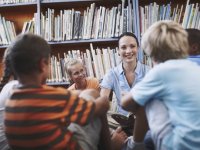Reflection, Conversation, and Socratic Spaces
Deepen students’ reflective process by offering them different perspectives from which they can empathize, ask questions, and relate the answers to the world they know.
Your content has been saved!
Go to My Saved Content.Learning communities are networks, systems that themselves grow and learn, propelled by the interactions of their members. Socratic spaces are a vital network element enabling learning for both individuals and groups, created by a collection of mindsets -- respecting a conflicting point of view, empathizing with the speaker, understanding cultural perspective -- and methods of knowing when to ask the probing "why" and "how" questions to drive thinking deeper. Paulo Freire identified these critical discussions as essential to learning: where our ideas conflict, our potential to learn is greatest. Where two beams of light intersect, their brilliance is most intense. In developing the minds of the future, we add the lever of technology and potentially move the earth.
Deepening the Reflective Process
Enter Mrs. Renee Cheng's fifth grade class, where students engaged in a three-week project using poetry, social issue-driven literature, in-class Socratic book clubs, and online platforms to deepen their reflective process. Our goal was to create a mixture of classroom discussion and lab space combined with an online platform to invite multiple forms of student expression. Students amazed us with their ability to revisit, rethink, and deepen their thinking.
Our project began within metered verse, the wails of the blues, and the polyrhythms of bebop jazz captured by Langston Hughes. We began by singing a blues version of "Madam and Her Madam," rapping "Children's Rhyme," and dramatically reciting "A Dream Deferred." To better grasp historical distance, we traced the line of thought from a young African American (". . . I know I can't be president. . .") to the modern times of Barack Obama's inaugural speech referencing Martin Luther King's "dream," then back to Langston's "dream deferred." After that, we dove into a closer analysis of "Madam and Her Madam," a narrative of a maid mistreated by her employer. Students grappled with writing in first person from four different perspectives -- the maid, the Madam, the poet, and the modern reader -- and then used iPads to capture their metacognition of the process in Explain Everything screencasts. With Google Sites as a sharepoint, students posted their thinking, gave feedback for homework, and the dialogue continued the following day in class.
The Right Mix of Ethos, Pathos, and Logos
The next phase of the project challenged students to a real-life practicum, a Skype interview with Australian poet Kevin Brophy at the University of Melbourne. To spark questioning, two of Brophy’s poems served as insight into his perspective. Through Google Docs, students brainstormed, edited, and refined their probing questions.
At 8:00 AM, we arranged arena seating around our projector screen. We laughed at the notion of us being in Brophy’s past, he in our future. Then one student, Omer, started with a bang:
One student posed questions while the class collaborated on collective notes. Kevin was playful and laughed with each student, picking up on minuscule details in their appearance and mannerisms, and then, through a mixture of poems he recited to the class and anecdotes from his own life, he dove straight into life's heartiest matters -- nationalism and identity, estranged parents, global warming, child abuse, how to maintain inspiration and creativity, and this advice on finding direction in life: "You don't really choose what you become -- you just become what you are."
The whole room was moved by the acuity of this poet's thinking and his glaring honesty with the students. I wondered if we had pushed our fifth graders into issues too deep to digest, but, as defined by Aristotle, the right mix of ethos, pathos, and logos makes something unavoidably interesting. Over the next few days, we watched as scattered seeds germinated.
Slow, Vibrant Conversation
That night, students transcribed the interview on a collaborative document, embellishing details like "a few moments of dramatic silence went by," and identified the most meaningful parts. In class, these highlights became the central focus of silent, slow-motion Socratic dialogues using post-its and butcher paper. We teachers emphasized that reading and writing are just very slow conversations that allow one to encapsulate thoughts before sharing them. To explore different platforms of expression, we digitized these threads using Mural.ly, a Google App that serves as an interactive posting board. A line from one of Brophy’s poems, "panic is our companion," instigated a vibrant discussion. A student named Jonah explained:
Slowing the discussion down, waiting for deep meaning, enabling students with multiple forms of expression, and using the digital platform to revisit themes brought out what we felt was authentic inquiry and reflection. While technology threaded through the project, it was never the focus but merely the tool, the vehicle to make learning more intense, more immediate, more flexible, more metacognitive, more integrative, more personal, and more fun!
